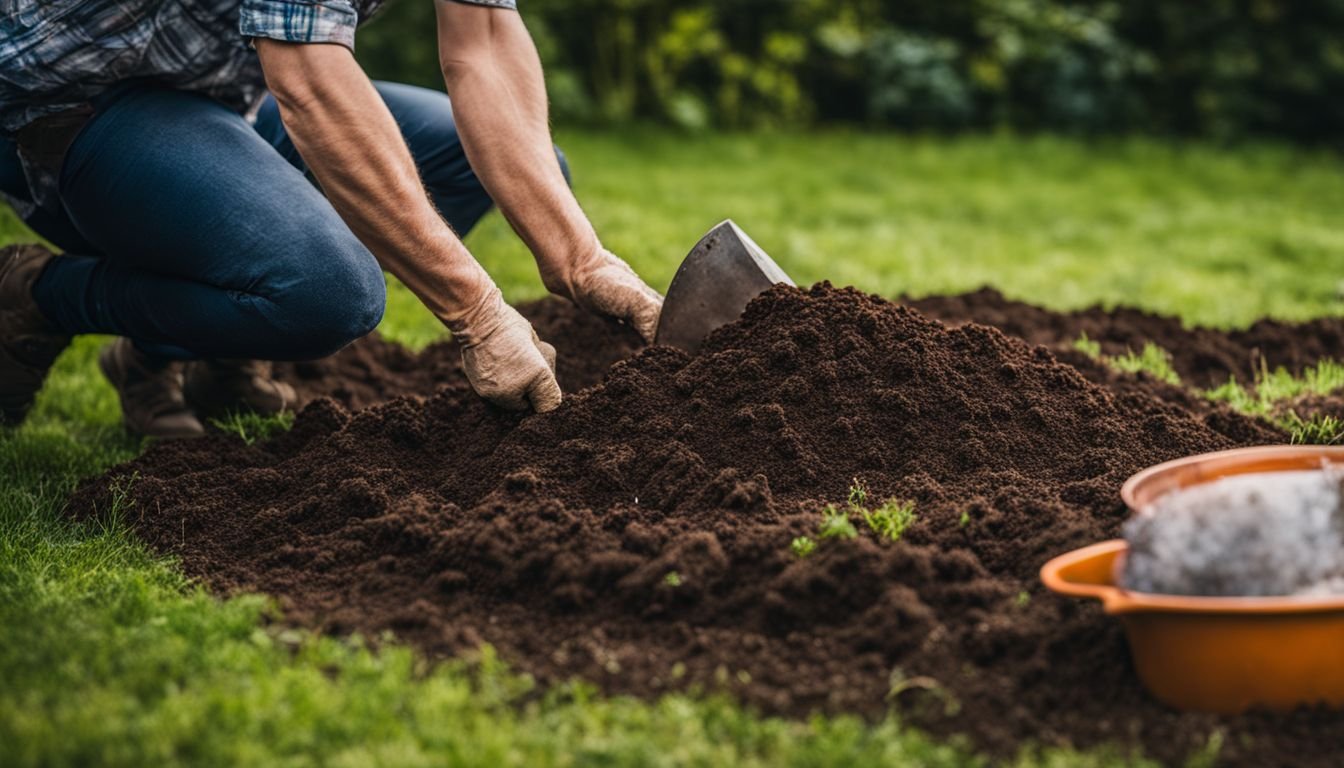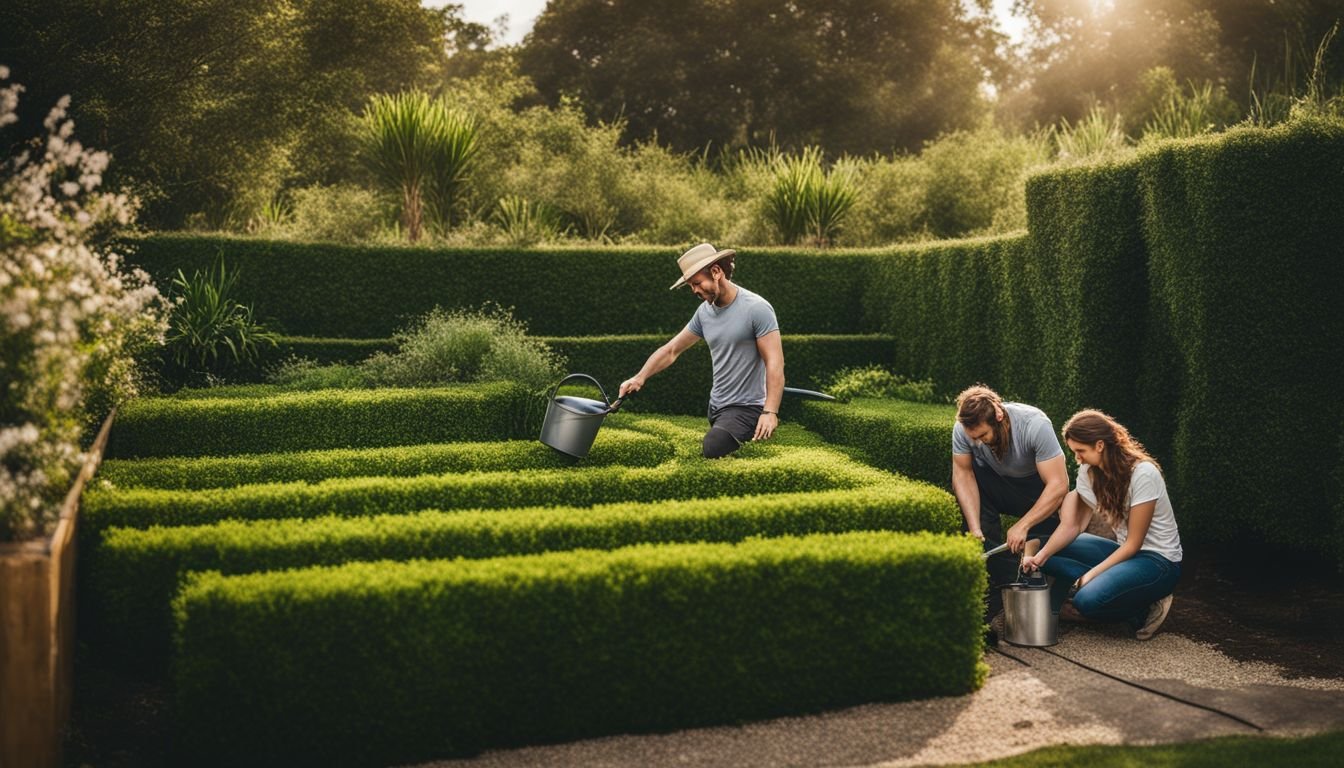Dreaming of adding a lush, living fence to your Aussie garden, but feeling a tad overwhelmed about where to kick things off? You’re not flying solo. Loads of us are chasing that perfect hedge for a bit more privacy or just to spruce up the backyard with something pretty and structured.
Been down that road ourselves! After digging deep into research, it turns out the secret sauce is picking the right green mate for the job. Ever heard how fast-growers like lilly pilly can get your hedge looking spick and span quicker than you’d think?
We’re here to guide you through prepping your soil, selecting top-notch plants, and giving them all the TLC they need until they’re ready to form an eye-catching hedgerow. From handpicking acmena smithii shrubs to getting crafty with holly bushes in topiary style, we’ve got it all covered.
Keen to give your garden a makeover? Stick around!
Key Takeaways
- Before planting your hedge, make sure to pick the right plants considering the garden’s climate, soil, and your privacy needs. Fast growers like lilly pillys can provide quick coverage.
- Prepare the soil properly by ensuring it drains well and is rich in nutrients to give your hedges a strong start. Sheep pellets can boost nutrient levels significantly.
- Plotting the line for your hedge and spacing plants correctly is crucial for an evenly grown, attractive barrier. Use markers to ensure each plant has enough space to thrive.
- Once planted, regular watering and mulching are key during the first year as this helps establish strong roots. Adding organic mulch keeps moisture in and adds nutrients over time.
- Pruning starts after giving hedges a year to grow strong. Using sharp tools for smooth cuts can shape your hedge beautifully while keeping plants healthy through their growing phase.
Selecting the Right Hedge Plants for Your Garden

We always keep in mind what we want our garden to look like and how quickly we need it to grow when picking hedge plants. If you’re aiming for a privacy screen or something to break the wind, fast-growing species like lilly pillys, Leyland cypress, podocarpus, bamboo, and Syzgium smithii are top choices.
Each of these has its own pace of growth and can quickly fill in space while providing the coverage you desire.
Choosing the suitable plant also means thinking about your garden’s specific climate and soil type. Plants that thrive in one location might not do well in another, so considering local conditions is crucial.
For instance, some shrubs prefer sunnier spots while others flourish in shade. Getting this match right means less worry for us later on as these plants will be more likely to grow strong and healthy without needing too much extra care from us.
Preparing the Soil for Hedge Planting

Good soil preparation is key before planting your hedge row. First, check that the spot you’ve chosen drains well. Nobody wants water to stay pooled around their plants’ roots – it spells trouble for hedge growth.
If drainage is poor, consider raising the bed slightly or working in some coarse sand to help water move through more easily.
Next up, enriching the soil will give your hedge plants a great start. Mix sheep pellets into the top layer of soil; these act like a magic potion, boosting nutrient levels and improving soil structure.
It’s all about creating an environment where those young hedges can thrive from day one.
A garden requires patient labor and attention. Plants do not grow merely to satisfy ambitions or to fulfill good intentions.
With the ground ready, we’re all set to dive into how exactly you plant that perfect hedge row in your Australian garden.
Step-by-Step Guide to Planting Hedges
We show you how to create a lush boundary in your garden step by step. Get ready to learn the art of planting hedges that will transform your outdoor space. Follow our guide for success!
Plotting the Line
We start by carefully measuring out where the hedge will go in your garden. Use a long piece of string and stakes to mark the straight line or shape you want your hedge to follow. This step makes sure your hedge grows neatly and looks good as part of your garden design.
Next, we check the line with a spirit level to ensure it’s perfectly horizontal. Adjustments are easy at this stage; just move the stakes until everything lines up right. This careful planning sets the foundation for a stunning hedge that enhances your outdoor space.
Spacing and Marking Holes
After plotting the line, we move on to spacing and marking holes. This step makes sure our hedge will look even and full. We use strings or garden hoses to mark where each shrub will go, keeping in mind their mature width.
Getting the spacing right means our plants will have enough room to grow without overcrowding. This encourages a dense, leafy appearance that makes for an attractive boundary.
We carefully place markers at each spot where a hole needs to be dug. Every marker stands as a promise of a plant’s future position in our garden tapestry. Adequate space between these markers prevents competition for soil nutrients and sunlight, key factors for healthy growth.
“A well-spaced hedge is a happy hedge.”
Transplanting the Shrubs
We start transplanting the shrubs by gently taking them out of their containers. This step is crucial for setting them up in their new spot in your garden. Each plant needs to sit snugly in a hole that’s just right—not too tight and not too spacious.
We then fill the space around it with soil to secure it properly, ensuring the environment promotes good drainage. This way, we avoid water standing still around the roots, which could harm your plant.
Next up, giving our newly transplanted friends a good drink helps them settle into their spots more comfortably. Water acts like a welcome hug for the roots, encouraging them to stretch out and strengthen within their new home.
After quenching their thirst, we apply wood mulch around each plant but keep it away from touching the stems directly. This layer keeps moisture in check and safeguards those tender roots beneath.
Trimming plays a big part after they’ve had some time to adapt—using steady movements ensures we shape our hedge neatly from one end to another. For those wider hedges calling for a bit more muscle, electric shears do wonders in making this job swifter and smoother.
Moving on lets us dive into how watering and mulching work together for thriving hedges.
Watering and Mulching
Once the hedge plants find their new home in your garden, it’s time to help them settle in with proper watering and covering the soil around them. Giving them a good drink frequently, especially during their first year, speeds up their growth.
Early on, they need more water because their roots haven’t spread out into the surrounding earth yet. Make sure to soak the ground deeply so that moisture reaches far down where roots can tap into it.
Adding a protective layer on top of the soil is also crucial. This step involves spreading mulch around your hedges. Using organic materials like straw or bark chips not only keeps moisture near the plant roots but also adds nutrients back into the soil as it breaks down over time.
This helps keep your hedges hydrated and happy even when temperatures climb.
Lastly, don’t forget about nourishing your plants regularly every six months to encourage dense growth for a lush hedge line. With these efforts combined – watering wisely and applying mulch – you create an ideal environment for your hedges to thrive in Australia’s unique climate conditions.
Tips on Pruning and Shaping Your Hedge
Giving your hedge the right shape and size takes patience and a bit of know-how. We always wait for our hedges to get strong for a year before we start cutting them back. This gives them time to grow deep roots and spread out.
Start with gentle cuts from one side of the hedge to the other, making your movements smooth to avoid tearing the plants. Use sharp tools – secateurs or hedge trimmers work best for this job.
Understanding how fast your chosen plant grows can help you plan pruning sessions better. For example, lilly pillys and Leylandii grow quickly, needing more frequent trims to keep them looking neat.
On the other hand, podocarpus might not need as much attention since it grows at a slower pace.
Next on our guide, let’s tackle some common questions about growing hedges that might be swirling in your head.
Commonly Asked Questions About Growing Hedges
How fast will my hedge grow? The speed at which your hedge becomes thick and tall depends on the type of plants you choose. Some species grow quickly, giving you a lush barrier in a short time.
Others take longer but often become denser and more durable over years. Regardless of the variety, providing well-draining soil, enough water, and regular maintenance will ensure steady growth.
Can I plant different types of shrubs together to create a unique hedge? Absolutely! Mixing various kinds of shrubs can add texture, color, and interest to your garden line-up. This approach lets you play with heights and hues while still fulfilling the practical purposes of privacy or wind-breaking.
Remember to consider each plant’s needs concerning soil type and sunlight exposure so that all members of your horticultural collection thrive.
Let’s move on now to discuss what comes after planting – caring for your newly installed green boundary.
Conclusion
Planting hedges in your Australian garden offers a beautiful, natural barrier that also serves as a windbreak or privacy screen. With the right plants and some basic gardening tools, you can transform your outdoor space.
Start by choosing plants that suit your garden’s need for speed and purpose. Then prepare the soil with good drainage and enrich it to give your hedge the best start. Regular watering and pruning help your green friends thrive.
Remember, growing a stunning hedge might take time, but with patience and care, you’ll see amazing results in no longer than seven years. Happy gardening!
FAQs
1. What do I need to start planting hedges in my Australian garden?
To start, you’ll need healthy plants recommended by a horticulturalist and the right tools for digging. Make sure your internet browser allows cookies if you’re looking up more detailed guides online.
2. How do I choose the best spot for my hedges?
Look for a spot that gets enough sunlight and has good soil. A horticulturalist can give advice on the best position based on your garden’s conditions.
3. Can I plant different types of hedges together?
Yes, you can mix different types of hedge plants as long as they have similar needs for water and sunlight. It’s a good idea to check with a horticulturalist to make sure your chosen plants will grow well together.
4. Do I need any special care tips after planting my hedges?
After planting, water your new hedges regularly until they’re established, and check if there are specific care instructions from the horticulturalist or nursery where you bought them.
